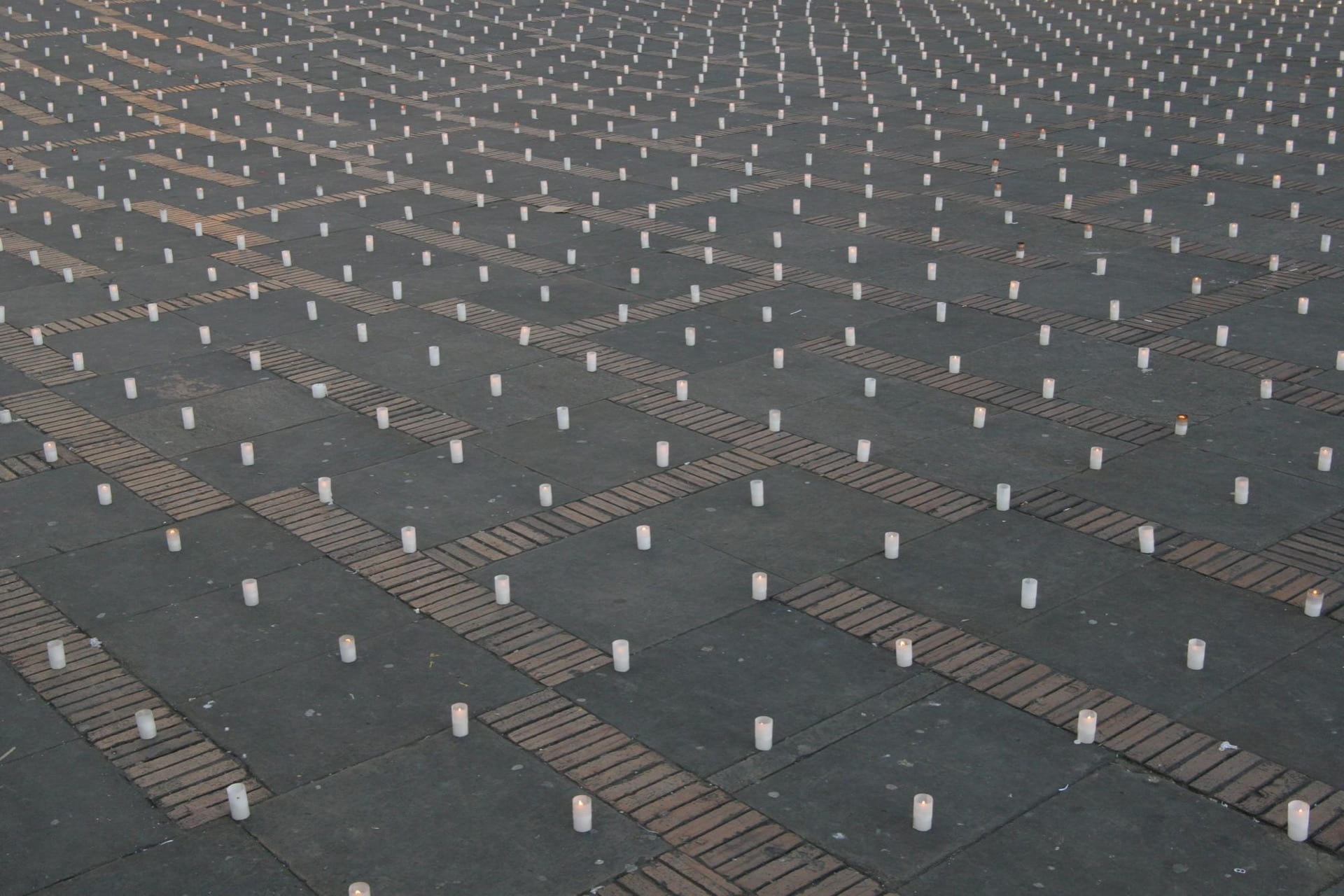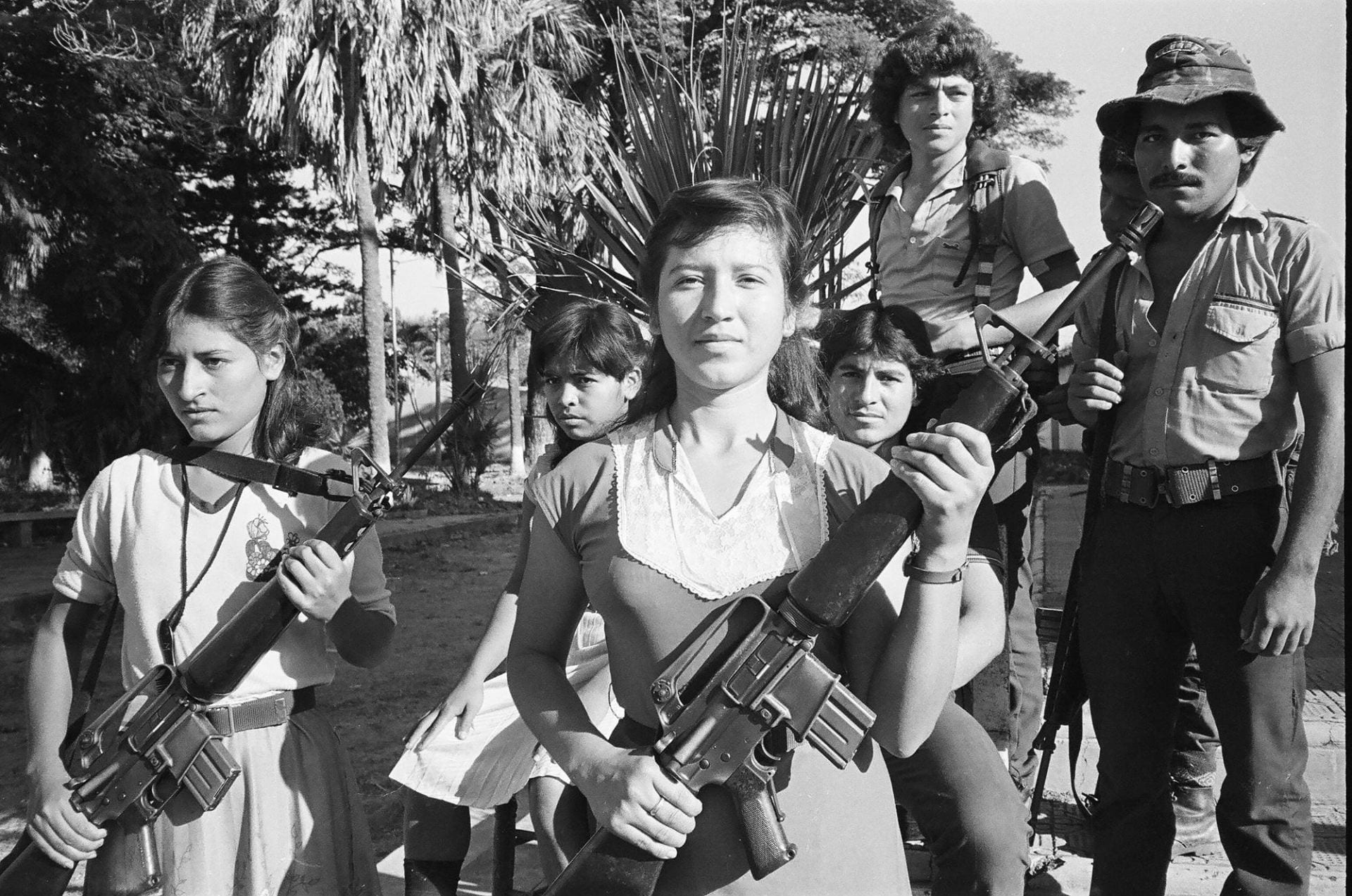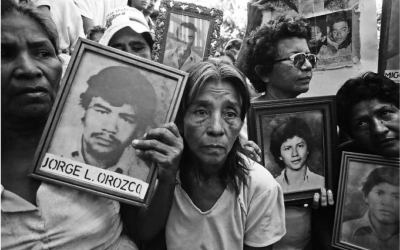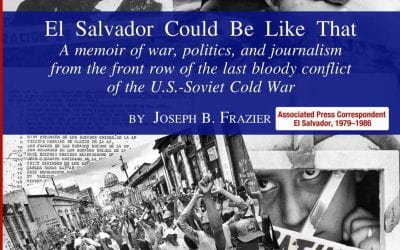A Search for Justice
After the Colombian Holocaust

In July 2007, Colombian artist Doris Salcedo created an installation “Acción de Duelo”- “Action of grieving” – with 25,000 candles placed in the Plaza de Bolivar in Bogota. Photo by Alex Fattal
Dear June,
In 2004, when I left Harvard and last saw you, I thought I would never learn the truth of what exactly happened to Carlos Horacio in the horrendous holocaust of the Palace of Justice in Bogotá. Yet fate was holding a tremendous surprise for my daughters and me, filled with pain and future challenges, which would uncover an important part of the story.
More than twenty years after the attacks on November 6 and 7, 1985, the Supreme Court embarked on a great effort to reconstruct the events. At the same time, it began a judicial process to discover what happened to the 11 people who disappeared from the conflagration. [Court magistrate Carlos Horacio Urán, Ana María’s husband, perished during the events of the Palace of Justice takeover by the M-19 guerrillas and the subsequent Army siege of the palace.]
In 2007, agents of Bogota’s prosecutor’s office discovered a safe deposit box hidden in a Colombian military compound, which would change our lives. The box—kept by the Colombian Army for more than 20 years—contained my husband’s wallet with a bullet hole, and other personal effects: documents; photographs of our family, four religious scapular medallions—I assume for our four daughters—his Kellogg Institute carnet and his driving license from the state of Indiana, where we had lived for some time.
There was also a typed list in the box with the names of the guerrilla members who had been killed in the attack. The names of magistrates Manuel Gaona and Carlos Horacio Urán had been scrawled in pencil and added to the list.
The discovery of the box reinforced the results of the autopsy performed after his death. There was little doubt that, unbeknownst to my daughters and me, my husband’s death had been a homicide with the involvement of the Colombian Armed Forces. But the public told me that the statute of limitations for homicides in Colombia is 20 years. The time had passed. I was devastated. I felt that the prosecutor’s office had returned Carlos Horacio’s remains to me, to then leave me with no place where to deposit them.
I knew that Carlos Horacio was only one of many victims, but pursuing justice for one meant memory for all. The outcome of the fateful M-19 subversive guerrilla attacks, followed by the Army’s reckless retaking of the Palace, using tanks and bombs inside the facilities, was frightful. Almost one hundred people died, among them most of the Supreme Court and Council of State justices of the time, including my husband, as well as other government officials and workers. Eleven people disappeared and have never been found.
Carlos Horacio also disappeared for more than 48 hours. From the very beginning, there were conflicting stories about his death. When the attack was over, I got a call from a journalist I did not know, urging me to look for my husband. She had seen Carlos Horacio leaving the building alive; “He has an injured foot, but he is alive,” she said. We couldn’t find him anywhere, however, no matter how much we looked.
At 7:30 p.m., a local news station showed a series of images of the last hostages leaving the Palace. Among them, we glimpsed Carlos Horacio limping on one foot and escorted by two uniformed men. With the help of some other journalist friends, I got a copy of the tape. The next day I brought the newsreel to the Defense Ministry. I could not find my husband without their help. Yet the Ministry Officials dismissed me, stating that they had no information. The Army nevertheless kept the tape. Hours later, Carlos Horacio’s lifeless body was found in the morgue.
Confusion reigned over his death and the autopsy results revealed no clear indications of how he had died. I was given many versions of the last moments of his life, but one became the official version: a surviving magistrate told me that Carlos Horacio had been killed by Army crossfire. According to his account, together with magistrate Manuel Gaona and Dr. Luz Estela Bernal, my husband had been gunned down by the Army as they tried to rescue hostages holed up in the bathroom; he had perished on the staircase.
At that point, I thought that my source, a magistrate of Colombia’s Highest Administrative Court, a public figure, and someone I knew, had no reason to lie to me. The magistrate, who held a right-wing ideology and was close to the Army, had absolutely no reason not to blame the guerrillas, I thought. In the midst of my pain, I accepted this version of Carlos Horacio’s death, which became the official version.
A lingering doubt remained in my mind, however: the journalist’s version, someone I had never met, coincided with the images in the video. Could Carlos Horacio have survived the guerrilla attack? But at that point, whom could I turn to?
Like many, we were not sure what had happened to our loved one, and like many victims, we and our dead were stigmatized by the victimizers. In addition to finding out what happened to my husband, I had to defend his honor. After the attack, a right-wing journalist, Darío Silva Silva, tried to tie Carlos Horacio to the M-19, the guerrilla group that originated the attack on the Palace of Justice.
This was so hard on me and my daughters; it was hard to grieve when we were constantly on the defensive and uncertain about the events leading up to his death.
Carlos Horacio’s ardent Christianity, closely tied to early Liberation Theology (of the 1960s-1970s) and his defense of democratic political participation through social movements, were interpreted in the most negative light. However, the facts speak for themselves. Carlos Horacio was not only a lawyer, and a member of Colombia’s Highest Administrative Court; he was also a young legal scholar with interdisciplinary training. At the time of the attack, he was completing his doctoral dissertation in political science on the participation of the Colombian Army in the Korean War at the University of Paris-I, Sorbonne. He had previously completed masters’ degrees in Philosophy of Law and Administrative Law, respectively and worked briefly at the French Conseil d’Etat. Just before the tragedy, we’d spent time at the Kellogg Institute at Notre Dame and in the Washington DC National Archive, in order for him to continue his doctoral research. One of his most recent publications had been a working paper on President Belisario Betancur’s peace process, later published in the reputable French newspaper Le Monde Diplomatique. None of this seemed to matter to moderate the hostility.
To add fuel to the fire, a person who claimed to be an Army official kept showing up at my office at the University of Los Andes, inviting me to give lectures at the War School. When I said I wouldn’t do it, this person began to tell me that I should leave the country with my four daughters because “rivers of blood were going to flow in Colombia.” I panicked.
In December 1987, I made the difficult decision to go into exile with my family, taking advantage of a generous invitation from Duke University in Durham, North Carolina. After 18 months there, we left for the Universidad de Alcalá de Henares in Madrid, Spain, until 1992. Things seemed to be changing in Colombia with the enactment of the 1991 Constitution and the establishment of an amnesty for the M-19 group. I decided to return and resume teaching at Los Andes and at the National University in Bogotá. What had actually happened at the Palace of Justice was still a mystery, and the families of the eleven people who had disappeared continued fighting to find out the whereabouts of their loved ones. The ghosts of the events reappeared constantly in the memory of many Colombians, and finally a Truth Commission was established in 2005 to unveil the true story. My daughters and I had made every effort to continue with our lives, albeit with great difficulty.
Then the discovery of the secret box in 2007 sent our lives into a spiral. After the Prosecutor had called me to inform me of this discovery and explained the difficulties we faced to commence a criminal proceeding in Colombia, I profoundly felt the need to get to the bottom of Carlos’ death. I had to do it, not only for me and for my daughters, but for the country as a whole.
I began desperately searching the videos of the surviving hostages, without success. Then, in August 2007, both the prosecutor’s office and I separately, found two different versions. The prosecutor’s tape had been found in the house of the colonel who had directed part of the Army’s retake of the Palace of Justice in 1985; he was being investigated for his actions in such events. It contained images similar to the video I had found just a day before meeting the prosecutor. By coincidence, the day after our meeting, a well-known journalist contacted me; he had found yet another video. The search was finally paying off. In addition, the report issued by the Colombian Truth Commission acknowledged subsequently that Carlos Horacio had left the Palace alive in company of members of the Armed Forces and that he was later found dead. This time, we were closer to finding out the truth. Months had gone by, though, and no legal proceedings had been initiated. I thought I was going to go crazy.
I approached the families of those eleven people who had disappeared from the Palace of Justice. They had more experience than I had, and they gave me some new tips. Their search had never ceased and they had brought a petition before the Inter-American Commission on Human Rights, and had initiated criminal proceedings in Colombia. Finally, at the beginning of 2009, the public prosecutor’s office opened the case: the statute of limitations could not apply because Carlos Horacio’s extrajudicial execution by the Colombian Army qualifies as a crime against humanity.
With our authorization, the prosecutor in charge of the case exhumed Carlos Horacio’s body and performed forensic studies, including ballistics testing. In June 2010, suspicions became certainty: he had been executed, presumably by the Colombian Army, after being tortured and subsequently brought back to the Palace of Justice to cover the homicide.
The case’s lead prosecutor, Ángela María Buitrago, a brave woman, summoned the three generals who had directed the counterattack for questioning. The next day, she was removed from her post, ironically on grounds of inefficiency. A new, lower-ranking prosecutor was appointed. To date he has done nothing but weaken the evidence. It took 18 months, and several petitions, for the body to be returned to us after being exhumed—even more pain.
With these investigations, we believe we have established the truth—as tough as it is—but we are lacking justice.
The Colombian courts have sentenced two of the officials who led the operations relating to the disappearance of the 11 people. However, shortly after the sentences were handed down, both Presidents Álvaro Uribe and Juan Manuel Santos have publicly announced their disapproval of the decisions, clearly affecting and infringing on the judiciary’s decisions. Carlos Horacio’s case is still pending before the Colombian criminal justice with little or no progress.
In 2011, the Inter-American Commission on Human Rights found the Colombian State responsible under international law for these events, and submitted the case before the Inter-American Court on Human Rights. In this latter proceeding, Colombia, represented by an allegedly independent inter-ministerial agency created to defend the state in these and other legal proceedings (ANDJE for its Spanish acronym), is now denying that the disappearance and executions ever took place. Even more importantly, current or former members of the Colombian Army appear to be controlling the ANDJE (by, among other mechanisms, imposing the line of arguments and vetoing which counsel shall be retained). This is of great concern to us as a family and as citizens.
By permitting the intervention of the Armed Forces to cover up grave violations of human rights, the ANDJE, and thereby the Colombian State, is not only compromising the agency’s institutional integrity and failing its mission of protecting the state as a whole, but it is also attempting to cover up crimes against humanity and ensuring the impunity of those responsible for the death of my husband and for other crimes committed as a result of this painful and controversial episode in Colombian history.
As you can see my friend, the truth about the facts themselves and their historical significance has still not been clarified. At the present time, the Colombian executive is making renewed efforts to put an end to the armed conflict. In order for the current peace process to prosper, it is fundamental to satisfy the demands for truth, justice and reparation. The case of the Palace of Justice is an emblematic one, fixed in the heart of Colombians. Thus it calls out, perhaps more than any other case, for an end to the impunity and the lack of truthfulness about what happened. Since that day in 1985, Colombians have watched as the system of justice grows weaker by the day while militarism is strengthened.
Without truth, there is no justice and without justice, there can be no peace, well-being or economic prosperity. Without truth, there is no strengthening of a legitimate state and accompanying democracy.
The importance of seeking the truth of the Palace of Justice conflagration was even underlined in U.S. Department of State reports presented to the Congress in 2010 and 2011, in which the failure to clarify these events was held up as proof of Colombia’s continuing human rights challenges.
The Inter-American Court on Human Rights has called for a hearing in October 2013. Let’s see what that court rules, and whether the Colombian state chooses to abide by those decisions. The videos and the secret box have changed my life since I last saw you. Let’s see if they can work for justice.
Ana María Bidegaín is the research director of the Latin American and Caribbean Studies Center at Florida International University and a professor in the Department of Religious Studies. Bidegaín founded the History Department at the University of Los Andes in Bogotá and opened the field of Religious Studies at the National University. She was a Visiting Professor at the Center for Women in Religion at Harvard Divinity School in 2003-2004.
Related Articles
Memory: Editor’s Letter
Editor's Letter Memory Irma Flaquer’s image as a 22-year-old Guatemalan reporter stares from the pages of a 1960 Time magazine, her eyes blackened by a government mob that didn’t like her feisty stance. She never gave up, fighting with her pen against the long...
A Search for Justice in El Salvador: One Legacy of Ignacio Martín-Baró
In the small rural town of Arcatao, Chalatenango, Rosa Rivera clung to the hope that one day she would find the remains of her disappeared mother and father and lay them to rest in peace. Others sought to exhume mass graves hoping to recover bodies of nearly 1,000 relatives massacred in the Río Sumpul. …
El Salvador Could Be Like That: A Memoir of War, Politics, and Journalism from the Front Row of the Last Bloody Conflict of the U.S.-Soviet Cold War
“There are no just wars. There are only just causes.” I was sitting in the modest home of a former FMLN guerrilla woman in a rural village in the northeastern corner of El Salvador. It was 2001, and I was nearing the end of my second year-long stint in this small Central American nation, interviewing more than 200 Salvadorans, mostly from rural areas, about their experiences during the civil conflict of the 1980s. …




